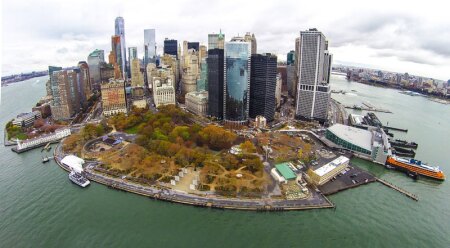Only about 25 percent of U.S. jurisdictions have adopted the relevant hazard provisions of the most recent building codes, according to the Federal Emergency Management Agency. However, as climate change worsens and the intensity of extreme weather–related events increases, even meeting modern building codes may not be enough.
To fill the gap, municipalities, nonprofit organizations, and industry groups are developing climate resilience design standards and tools, some of which are required or incentivized for publicly funded projects, and others of which may become expected or required for commercial real estate transactions, experts say. Boston, New York City, and Washington, D.C., have created resilience design standards in recent years to address the level of climate risk these coastal locations face.
“It’s exciting to see more places begin to encourage the assessment of climate risk, and we’re also seeing a trajectory from voluntary to mandatory for some project types,” says Lindsay Brugger, vice president of urban resilience for the Urban Land Institute. “In New York City, for example, Local Law 41 passed last year, mandating that city capital projects utilize the city’s Climate Resiliency Design Guidelines.”
Massachusetts has followed a similar model, she adds, creating a resilience design tool for the public sector that can also be used by the private sector. “The state’s Climate Resilience Design Standards Tool provides a preliminary analysis of climate risk and recommended design guidelines that can help to address those physical risks,” Brugger says. Developed to help cities and towns applying to the state’s Municipal Vulnerability Preparedness grant program, the tool is also freely available to privately funded projects.
Flexibility Is Key
Even if resilience standards become more widely required, flexibility is key to successful implementation, as outlined in Building Climate Resilience in Cities Worldwide: 10 Principles to Forge a Cooperative Ecosystem, a report created by a partnership between the Centre for Liveable Cities, Singapore, and ULI. “One of the strengths of these resilience design guidelines is that they have a degree of flexibility built in, which allows the design team and the development team to innovate and encourages them to understand their risk so they can address it in a way that works best for the situation at hand,” Brugger says. “Risks vary substantially based on where you are, and the climate is always evolving.”
Nonprofit organizations and industry groups have also created a wide range of useful resilience standards and guidelines as well, notes Natalie Ambrosio Preudhomme, associate director at Moody’s Analytics CRE, and some of them already provide incentives. For example, in certain jurisdictions, properties in communities that meet the National Fire Protection Association’s Firewise USA standards are eligible for insurance premium discounts, and developers may factor this into their marketing for new properties, she explains.
Other standards are likely to translate into requirements down the road, Ambrosio Preudhomme adds. These include the National Council of Real Estate Investment Fiduciaries (NCREIF) and the Pension Real Estate Association’s NCREIF PREA Reporting Standards, which cover environmental, social, and governance reporting best practices, with components related to both physical and transition climate risks, including key performance indicators.
Moody’s and RMS, a global provider of climate and natural disaster risk modeling and analytics, are involved in a working group for ASTM International that is drafting a new guide for property resilience assessment for commercial real estate lending or acquisition decisions. “It’s likely that over time, these will become required for commercial real estate transactions, which would have a huge impact in helping standardize resilience measures,” Ambrosio Preudhomme says. “Some commercial real estate trade organizations have even recommended to the U.S. Securities and Exchange Commission that these kinds of guidelines become the default for property vulnerability and resilience disclosures in financial filings.”
Eventually, Ambrosio Preudhomme believes, standards like these “will likely become required for members of these key industry organizations, or generally expected behavior for transactions, which would have a huge impact in standardizing climate resilience strategies in commercial real estate lending or acquisition decisions.”
Additional Resources:






